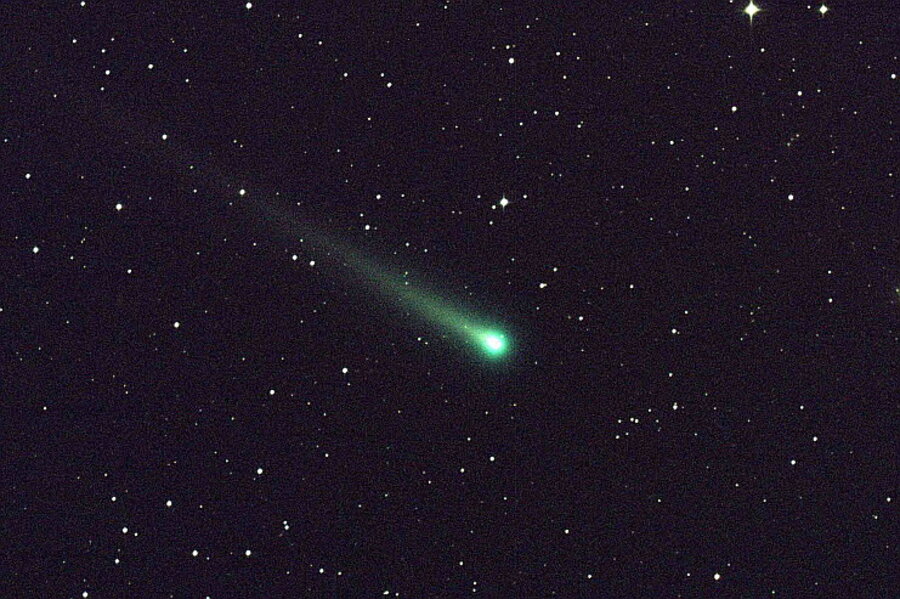Comet ISON puts on a show. Will it survive its solar flyby?
Loading...
Comet ISON, an interloper from the Oort cloud that one way or another isn't long for this solar system, has undergone a burst of brightness in the past 24 hours – just nine days shy of its close encounter with the sun.
Although not as intense as a burst last week, the increase is adding to speculation over whether the comet, formally known as C/2012 S1, will survive its Nov. 28 solar flyby.
The comet is projected to sweep past the sun a scant 1.2 million miles above its surface. If it does survive, its first pass through the solar system will be its last. The encounter with the sun will kick ISON out into interstellar space, researchers calculate.
Some astronomers have suggested that ISON already is beginning to lose chunks of its nucleus. During the weekend, researchers with the Max Planck Institute for Solar System Research reported that ISON had sprouted “wings” – additional streaks of dust and ionized gas erupting from its nucleus and flowing alongside the comet's tail.
“Features like these typically occur after individual fragments break off the nucleus,” noted Hermann Böhnhardt, one of the astronomers reporting the observation.
The wings appeared only after images of the comet were subjected to sophisticated image-processing techniques; they don't appear to the naked eye, the researchers said.
But not everyone is convinced the wings were evidence that the nucleus was losing fragments.
“I think it was just a flare-up,” says Matthew Knight, an astronomer with the Lowell Observatory in Flagstaff., Ariz., who is taking part in the international campaign to record and analyze ISON's passing. “These things probably fluctuate quite a bit when they start getting this close to the sun just because they are hitting new temperatures – especially with a comet like ISON, which hasn't been close to the sun before.”
Indeed, the comet's fresh face is a major reason that researchers have been keenly interested in observing it, Dr. Knight says.
The comet is thought to have originated in the Oort cloud, a vast collection of construction debris from the formation of the solar system some 4.6 billion years ago. Trillions of objects larger than about a half mile across are thought to form a kind of shell as they orbit the sun. Such a shell begins a few hundredths of a light-year from the sun and extends to nearly one light-year away.
No one has observed the Oort cloud, but astronomers infer its presence from their observations of long-period comets, which swing through the solar system every 200 years to every few million years.
Observations of ISON's path since its discovery last year tie it to the Oort cloud, Knight says. And the slow place at which it has brightened on its travels toward the sun suggest that it's first losing a relatively pristine layer of dust and rock on its surface. This gradually exposes more of the ices mixed into its interior, allowing them to quickly vaporize and form the luminous tails of dust and ionized gas, as well as the halo around the comet's core. ISON has not been brightening as quickly as returning comets typically do, he notes.
ISON – named after a collaboration of astronomers called the International Scientific Optical Network – is the first comet on record to come from so far away and pass so close to the sun on its first pass, Knight says. Thus, researchers are getting a rare opportunity to analyze some of the most pristine evidence available that's associated with the nebula of dust and gas that gave rise to the sun and planets.
If ISON survives, it would give researchers a way to test the notion that Oort-cloud objects probably originated much closer to the sun and were kicked outward through encounters with the giant planets, which orbit beyond Mars.
“We're hoping that there may be a difference in what we see before perihelion and after,” Knight says, referring to the comet's closest approach to the sun. Changes in composition of the material ISON sheds after it loses much of its surface, which had 4 billion years to accumulate, could help confirm the migration idea.
“This really is a unique opportunity, regardless of whether it lives up to the brightness predictions that came out a year ago,” Knight says.
But some evidence suggests ISON may not make it for the outbound show.
Modeling work that Knight and colleague Kevin Walsh, with the Southwest Research Institute in Boulder, Colo., performed earlier this year looked at a range of important comet characteristics and estimated ISON's odds of survival based on a range of values for those traits.
Since then, astronomers have pinned down the values for some of the traits for ISON. The news isn't encouraging.
Researchers using the Hubble Space Telescope, Knight notes, estimated that the comet is rotating once every 10 hours, a pace fast enough to enhance the changes of a breakup if the nucleus is less than 1.2 miles across, according to the modeling results.
Indeed, the comet “is frighteningly small," says Alan Delamere, a comet specialist in Boulder, Colo., who used data from NASA's Mars Reconnaissance Orbiter to estimate the comet's size.
It was a difficult measurement to make, Dr. Delamere says. Among other things, he assumed that the image captured by the orbiter's HiRISE camera was all nucleus, with no extended coma. That would give the comet a maximum diameter of about 0.6 miles.
But the nucleus clearly has a coma, so it's likely to be significantly smaller than the maximum estimate he came up with, he says.
None of this indicates that a breakup is inevitable, but it does raise the stakes, the researchers say.
All of which suggests that to try to catch a glimpse of C/2012 S1, there's no time like Wednesday morning before sunrise, weather willing and pair of binoculars in hand.





